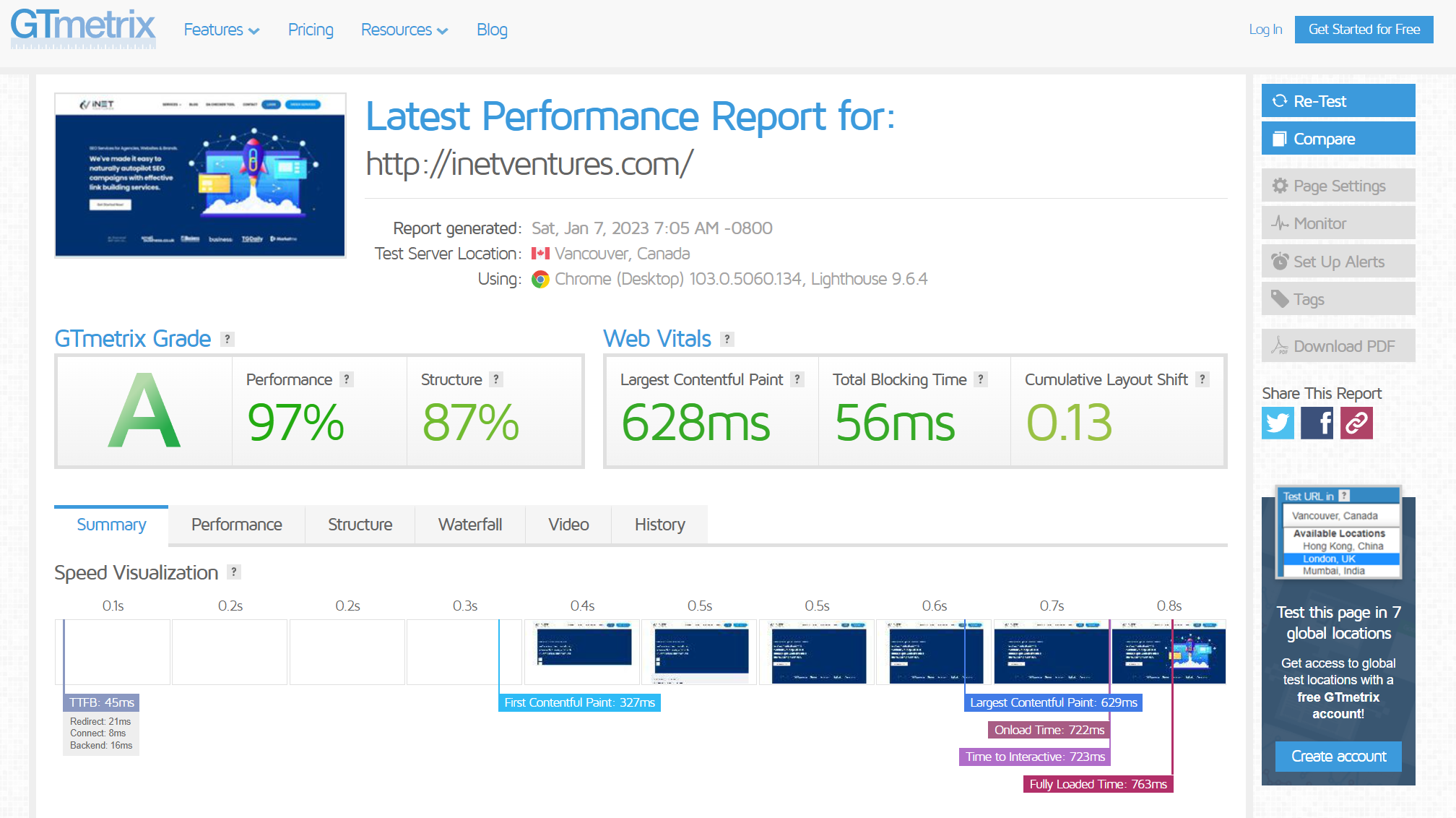GTmetrix is a website performance tool that analyzes the speed and performance of a website and provides recommendations for improvement. The tool measures a number of factors that can impact the speed of a website, including the size and number of requests made by the website, the use of caching, and the presence of render-blocking resources.
Using GTmetrix is simple. First, you enter the URL of the website that you want to test into the tool. GTmetrix will then run a series of tests and provide a detailed report on the performance of the website. The report includes a score for the website’s performance, as well as a breakdown of the different factors that contribute to the score.
One of the key features of GTmetrix is its ability to provide recommendations for improving the speed and performance of a website. These recommendations can include things like optimizing images, minifying CSS and JavaScript, and using a content delivery network (CDN). GTmetrix also provides information on the specific resources that are causing issues with the website’s performance, making it easy to identify and fix problem areas.
In addition to its performance analysis and recommendation features, GTmetrix also includes a number of other useful tools. For example, the tool allows you to test the performance of a website on different devices and browsers, and it includes a timeline feature that shows how the website loads over time.
Here are 12 features of GTmetrix:
- Page load time: GTmetrix measures the time it takes for a web page to fully load and displays it in a report.
- Page size: GTmetrix displays the size of a web page and its components, including HTML, JavaScript, and CSS files.
- Page speed score: GTmetrix assigns a grade to a web page based on its performance and loading speed.
- Waterfall chart: GTmetrix provides a visual representation of the loading process of a web page, showing the order in which different components are loaded.
- Page analysis: GTmetrix analyzes a web page and its components, identifying any issues that may be affecting its performance.
- Recommendations: GTmetrix provides recommendations for improving the performance and loading speed of a web page.
- Comparison to other websites: GTmetrix allows users to compare the performance and loading speed of their web pages to those of other websites.
- Integration with Google Analytics: GTmetrix can be integrated with Google Analytics to track the performance of a web page over time.
- Mobile analysis: GTmetrix includes a mobile analysis tool that allows users to test the performance of their web pages on mobile devices.
- Advanced features: GTmetrix offers advanced features for users who need more detailed analysis, including the ability to test the performance of a web page on different servers and connection speeds.
- API access: GTmetrix provides API access for developers who want to integrate its performance analysis tools into their own applications.
- Security: GTmetrix uses secure servers and data encryption to protect the privacy of its users.

Why You Need Website Speed Optimization
Website speed optimization is the process of making your website load as quickly as possible for users. This is important for a number of reasons. First, a slow loading website can be frustrating for users, leading them to leave before they even see what your site has to offer. This can result in lost traffic and revenue. Additionally, search engines like Google take into account the speed of a website when ranking it in search results. A faster website will rank higher than a slower one, which can also lead to more traffic and revenue.
One of the most effective methods for optimizing the speed of your website is to properly size and compress your images. Large images can significantly slow down the loading time of your website, so it is crucial to ensure that they are optimized. This can be done using various tools such as Adobe Photoshop or online resources like TinyPNG. By properly optimizing your images, you can greatly improve the speed of your website.
Caching is another effective method for optimizing the speed of your website. By storing commonly used files in the user’s browser, your website can avoid the need to download these files again each time the user visits the site. This can significantly improve the speed of your website for returning visitors and enhance the overall user experience.
In order to optimize the speed of your website, it is necessary to not only optimize images and utilize caching, but also to employ other techniques such as minimizing the use of JavaScript and CSS, optimizing your website’s code, and utilizing a content delivery network (CDN).
Overall, website speed optimization is an important aspect of running a successful website. By ensuring that your site loads quickly, you can improve the user experience, increase traffic and revenue, and rank higher in search results.
There are several reasons why you might want to optimize the speed of your website:
- Enhanced user experience: One of the main benefits of optimizing the speed of your website is the improved experience it provides for users. A website that loads quickly is more likely to keep visitors on the site and encourage them to interact with it. This can lead to increased traffic and revenue for your business.
- Increased conversion rates: Faster loading times have been shown to increase conversion rates, as users are more likely to complete a purchase or sign up for a service when the process is quick and smooth.
- Improved search engine rankings: One of the benefits of a faster-loading website is that it is more likely to rank higher in search engine results. Google and other search engines use website loading speed as a ranking factor, so a website that loads quickly will have an advantage over slower-loading sites.
- Decreased bounce rates: When a website takes a long time to load, users are more likely to leave before the page finishes loading. This can result in high bounce rates, which can negatively impact the traffic and revenue of a website. By optimizing the speed of your website, you can reduce bounce rates and improve the overall performance of your site.
- Lower hosting costs: Optimizing a website’s loading speed can reduce the strain on the server and lower hosting costs.
Optimizing the speed of your website can help improve the user experience, increase conversion rates, and improve search engine rankings. It can also help reduce bounce rates and lower hosting costs.
Overall, GTmetrix is a valuable tool for anyone looking to improve the speed and performance of their website. By providing detailed analysis and recommendations for improvement, GTmetrix makes it easy to identify and fix issues that are slowing down your site.



